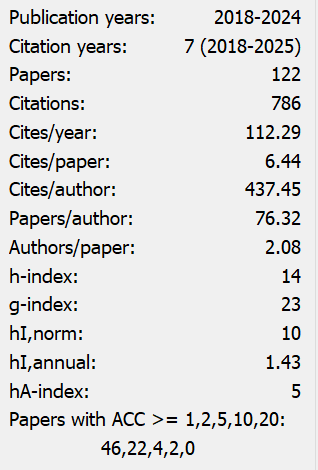Influence of Interest Rate on Industrial Output in Nigeria
Abstract
The study examined the effect of interest rate on industrial sector in Nigeria from 1980 to 2018. The data for the study were sourced from Central Bank of Nigeria (CBN) statistical bulletin and Autoregressive Distributed Lag model was used as the main analytical tool. The ARDL Bounds test revealed the existence of long run relationship among the variables. The result further revealed the existence of a positive relationship between interest rate and industrial output both in the long run and short run. The rate of inflation was negatively related to industrial output but the relationship was not significant in both the short run and the long run. The number of labour force affected the productivity of industry thereby increasing its output in both the short run and the long run. Gross investment has a positive relationship with industrial output but the relationship was not significant. Lastly, foreign direct investment was not significant in affecting industrial output in the short run but it was positive and significant in affecting industrial output in the long run. The study concluded that interest rate has the ability to influence industry output in Nigeria. Therefore, the study recommended among others that the apex monetary institution - the Central Bank of Nigeria should ensure that the rate of interest that will encourage investors to borrow in order to start to do businesses or to expand their businesses. This will increase industry output and in turn support economic growth in Nigeria.
References
Adebiyi, M. A., & Obasa, B. B. (2004). Institutional Framework, interest rate policy and the financing of the Nigeria manufacturing sub-sector. Paper delivered at a forum for African macro-micro linkage, South Africa.
Adofu, I., Abula, M. & Audu, S. I. (2010). Assessment of the effects of interest rate deregulation in enhancing agricultural productivity in Nigeria. Current Journal of Economic Theory, 2(2), 82-86.
Aghion, P., Farhi, E., & Kharroubi, E. (2015). Liquidity and growth: the role of counter-cyclical interest rates. BIS Working Paper No. 489. Available at SSRN: https://ssrn.com/abstract=2564266
Aiyedogbon, J. O., & Anyanwu, S. O. (2016). Macroeconomic Determinants of Industrial Development in Nigeria. Nile Journal of Business and Economics, 1(1), 37-46. https://doi.org/10.20321/nilejbe.v1i1.44
Alao, R. O. (2010). International Liquidity/Reserves and Foreign Exchange Rates. Review in Social Sciences, 8, Adeyem: College of Education, Ondo, April (in press).
Ayodele, A. I., & Falokun, G. (2003). The Nigerian Economy: Structure and Patter of Development. Jodad Publishers.
Central Bank of Nigeria Annual reports And Statements of Account, various issues.
Central Bank of Nigeria Statistical Bulletin. (2010). various issues.
Central Bank of Nigeria. (2012). Statistical Bulletin, Abuja: CBN, 23.
Charles, A. N. B. (2012). Investigating the performance of monetary policy on the Manufacturing sector in Nigeria. Arabian Journal of Business and Management Review, 2(1), 12-25. https://doi.org/10.12816/0002239
Chete, L. N., & Adenkinju, A. (1996). Productivity Growth in Nigerian Manufacturing and its correlation with Trade Policy Regimes/Indices. Research for Development, vol. 11 number 1.
Chete, L. N., & Adeoye, B. W. (2002). Human Capital and Economic Growth: The Nigerian Evidence. Paper presented at the 43rd Annual Conference of NES, Sheraton Hotels, Lagos, August 6-8, 2002.
Estimating A Monetary Policy Reaction function for the Central Bank of Nigeria. Retrieved December 23th, 2009. From http://www.africametrics.org
Ezeaku, H. C., Ibe, I. G., Ugwuanyi, U. B., Modebe, N. J., & Agbaeze, E. K. (2018). Monetary Policy Transmission and Industrial Sector Growth: Empirical Evidence from Nigeria. SAGE Open April-June 2018, 1-12. https://doi.org/10.1177/215824401876936
Fabayo, D. A. (2003). Foreign Private Investment in Nigeria Manufacturing Sector. A paper presented at the 12th Annual Conference of the Regional Research Units organized by the research department, CBN.
Falokun, G. O. (1998). Sources of Industrial Growth in Nigeria: A Factor Decomposition Approach. NISER Monograph Series Number 12, NISER, Ibadan.
Gbosi, A. N. (2015). Contemporary Macroeconomic Problems and Stabilization Policies (2nd edition). Spirit and Truth Publishers, Benin City, Nigeria.
Institutional Framework for Interest Rate and the Manufacturing Subsector. Retrieved from http://www.wikipedia.com
Kalu, I. E. (2001). Issues in Problems And Policies of Development. Development Economics, Mimeograph Series Number 1. Lagos, Techno Consult Ltd.
Niser. (2003). The Structure And Growth of the Economy in NISER Review of Nigerian Development, 2001/2002. NISER Publication.
Obamuyi, T. M. (2009). An investigation of the relationship between interest rates and economic growth in Nigeria, 1970-2006. Journal of Economic and International Finance, 1(4), 93-98.
Obamuyi, T. M., & Olorunfemi, S. (2011). Financial reforms, interest rate behavior and economic growth in Nigeria. Journal of Applied Banking and Finance, 1(4), 39-55.
Ogunkola, E. O., & Agah, Y. F. (2000). Nigeria And World Trading System. AERC/CREA Working Papers.
Okoye, L. U. (2006). The Impact of Interest Rate on Productive activities in Nigeria: A study of selected manufacturing industries in Nigeria. Unpublished Master of Business Administration Dissertation, Department of Banking and Finance, University of Nigeria, Nsukka.
Olofin, S., & Iyaniwura, J. (1983). Analysis of Intersectoral Linkages in the Nigerian Economy. The Nigerian Journal of Economic and Social Studies, 25(2).
Olomola, A. S. (2009). Regional Integration in the Context of Socio Economic transformations In Africa: Issues And Approaches.
Ozigbu, J. C. (2018). Interest rate deregulation and dynamics of industrial sector’s productivity in Nigeria. International Journal of Innovation & Development, 7(1), 323-332. https://doi.org/10.24940/ijird/2018/v7/i1/AUG17105
Productivity in the Nigerian Manufacturing Industry”. Retrieved from http://www.cenbank.org
Tomola, M. O., Adebisi, T. E., & Olawale, F. K. (2012). Bank Lending, economic growth and the performance of the manufacturing sector in Nigeria. European Scientific Journal, 8(3), 19-34.
Towards Sustainable Interest Rate. Daily Trust Newspaper. Retrieved from http://www.allafrica.com


This work is licensed under a Creative Commons Attribution 4.0 International License.
Copyright for this article is retained by the author(s), with first publication rights granted to the journal.
This is an open-access article distributed under the terms and conditions of the Creative Commons Attribution license (http://creativecommons.org/licenses/by/4.0/).


























